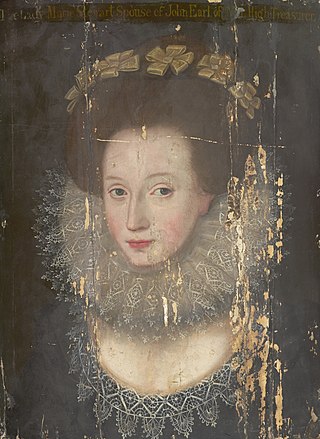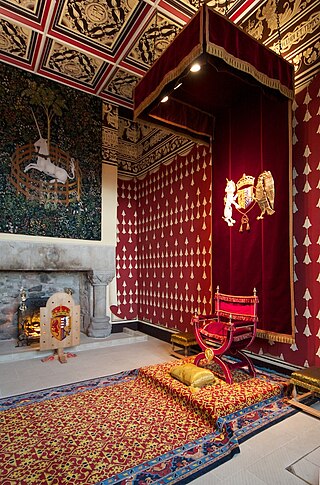Related Research Articles

Ludovic Stewart, 2nd Duke of Lennox and 1st Duke of Richmond, Lord of the Manor of Cobham, Kent, was a Scottish nobleman who through their paternal lines was a second cousin of King James VI of Scotland and I of England. He was involved in the Plantation of Ulster in Ireland and the colonization of Maine in New England. Richmond's Island and Cape Richmond as well as Richmond, Maine, are named after him. His magnificent monument with effigies survives in Westminster Abbey.
William Schaw was Master of Works to James VI of Scotland for building castles and palaces, and is claimed to have been an important figure in the development of Freemasonry in Scotland.
Sir William Stewart of Houston was a Scottish soldier, politician and diplomat.
Sir John Carmichael was a Scottish soldier, the Keeper of Liddesdale, a diplomat, and owner of Fenton Tower at Kingston, East Lothian.
Robert Bowes (1535?–1597) was an English diplomat, stationed as permanent ambassador to Scotland from 1577 to 1583.
Sir Richard Cockburn of Clerkington, Lord Clerkintoun (1565–1627) was a senior government official in Scotland serving as Lord Privy Seal of Scotland during the reign of James VI.
William Ashby or Asheby was an English politician and a diplomat sent to Scotland.

Marie Stewart, Countess of Mar (1576–1644) was a Scottish courtier. She was the daughter of Esmé Stewart, 1st Duke of Lennox and Catherine de Balsac d’Entragues (d. c.1631) and a favourite of James VI of Scotland. After her marriage, as was customary in Scotland, she did not change her name, and signed her letters as "Marie Stewart".

A masque was held at the baptism of Prince Henry on 30 August 1594 at Stirling Castle. It was written by the Scottish poet William Fowler and Patrick Leslie, 1st Lord Lindores.

Margaret or Margrethe Vinstarr, was a Danish courtier in Scotland to Anne of Denmark commemorated by the ballad "The Laird o Logie" for rescuing her imprisoned lover.
George Young was a Scottish churchman, courtier, member of the Privy Council of Scotland, diplomat, and secretary depute.

Henrietta Stewart (1573–1642) was a Scottish courtier. She was the influential favourite of the queen of Scotland, Anne of Denmark.

Peder Munk of Estvadgård (1534–1623), was a Danish navigator, politician, and ambassador, who was in charge of the fleet carrying Anne of Denmark to Scotland. The events of the voyage led to witch trials and executions in Denmark and Scotland.
Niels Krag (1550-1602), was a Danish academic and diplomat.
Andrew Keith, Lord Dingwall was a Scottish landowner, soldier, and diplomat.

On 17 May 1590, Anne of Denmark was crowned Queen of Scotland. There was also a ceremony of joyous entry into Edinburgh on 19 May, an opportunity for spectacle and theatre and allegorical tableaux promoting civic and national identities, similar in many respects to those performed in many other European towns. Celebrations for the arrival of Anne of Denmark in Scotland had been planned and prepared for September 1589, when it was expected she would sail from Denmark with the admirals Peder Munk and Henrik Gyldenstierne. She was delayed by accidents and poor weather and James VI of Scotland joined her in Norway in November. They returned to Scotland in May 1590.
Sir James Sandilands was a courtier to King James VI and I and captain of Blackness Castle

Queen Elizabeth I of England paid a subsidy to King James VI of Scotland from 1586 to 1602. This enabled her to influence James by delaying or deferring payments to his diplomats in London. Records survive of the yearly amounts, and details of the expenditure in some years. A large proportion of the money in 1589 was spent on the royal wedding and in subsequent years on the royal wardrobe of James and Anne of Denmark. Some royal expenses were met by Anne of Denmark's dowry, which was known as the "tocher". The regular incomes of the Scottish crown were feudal rents, customs, and "compositions" charged on grants of land. Accounts for royal incomes and payments survive as the exchequer rolls and lord treasurer's accounts and have been published as historical sources.

The Raid of Holyrood was an attack on Holyrood Palace, Edinburgh on 27 December 1591 by Francis Stewart, 5th Earl of Bothwell in order to gain the favour of King James VI of Scotland. Bothwell subsequently staged a raid at Falkland Palace, and in July 1593 made another attempt at Holyrood.

Anne of Denmark (1574–1619) was the queen of Scotland from her marriage by proxy to King James VI on 20 August 1589 and queen of England and Ireland from his accession on 24 March 1603 until her death in 1619. When Anne intended to sail to Scotland in 1589 her ship was delayed by adverse weather. Contemporary superstition blamed the delays to her voyage and other misfortunes on "contrary winds" summoned by witchcraft. There were witchcraft trials in Denmark and in Scotland. The King's kinsman, Francis Stewart, 5th Earl of Bothwell came into suspicion. The Chancellor of Scotland John Maitland of Thirlestane, thought to be Bothwell's enemy, was lampooned in a poem Rob Stene's Dream, and Anne of Denmark made Maitland her enemy. Historians continue to investigate these events.
References
- ↑ Liv Helene Willumsen, 'Witchcraft against Royal Danish Ships in 1589 and the Transnational Transfer of Ideas', IRSS, 45 (2020), pp. 54–99 at p. 60
- ↑ Miles Kerr-Peterson & Michael Pearce, 'James VI's English Subsidy and Danish Dowry Accounts', Scottish History Society Miscellany XVI (Woodbridge, 2020), pp. 1–2, 10, 93–4: Miles Kerr-Peterson, A Protestant Lord in James VI's Scotland (Boydell, 2019), p. 51.
- ↑ HMC Salisbury Hatfield, vol. 3 (London, 1889), p. 438.
- ↑ David Stevenson, Scotland's Last Royal Wedding (John Donald: Edinburgh, 1997), pp. 23–5, 136–7: Thomas Riis, Should Auld Acquaintance Be Forgot..., vol. 1 (Odense, 1988), pp. 264–5.
- ↑ Calendar State Papers Scotland, vol. 10 (Edinburgh, 1936), p. 187: David Stevenson, Scotland's Last Royal Wedding (Edinburgh, 1997), pp. 34, 89.
- ↑ Calendar State Papers Scotland: 1593–1595, vol. 11 (Edinburgh, 1936), p. 92.
- ↑ Annie I. Cameron, Calendar State Papers Scotland: 1593–1595, vol. 11 (Edinburgh, 1936), pp. 81, 92, 94.
- ↑ Michael Pearce, 'Anna of Denmark: Fashioning a Danish Court in Scotland', The Court Historian, 24:2 (2019), pp. 138–151, p. 150: Calendar of State Papers Scotland, vol. 11 (Edinburgh, 1936), p. 94 no. 63.
- ↑ Thomas Thomson, Memoirs of his own Life by Sir James Melville of Halhill (Edinburgh, 1827), p. 415.
- ↑ Annie I. Cameron, Calendar of State Papers: 1593–1595, vol. 11 (Edinburgh, 1936), p. 696.
- ↑ Thomas Thomson, The historie and life of King James the Sext (Edinburgh, 1825), p. 269.
- ↑ Annie I. Cameron, Calendar of State Papers: 1593–1595, vol. 11 (Edinburgh, 1936), p. 704.
- ↑ Thomas Thomson, The Historie and Life of King James the Sext (Edinburgh, 1825), p. 269.
- ↑ William Dunn Macray, 'Report on Archives in Denmark', 47th Report of the Deputy Keeper of the Public Records (London, 1886), pp. 32–3, 37.
- ↑ Calendar State Papers Scotland, vol. 11 (Edinburgh, 1936), p. 363.
- ↑ Thomas Rymer, Foedera, vol. 16 (London, 1715), p. 263.
- ↑ Miles Kerr-Peterson & Michael Pearce, 'James VI's English Subsidy and Danish Dowry Accounts, 1588–1596', Scottish History Society Miscellany XVI (Woodbridge, 2020), pp. 77–8, 87.
- ↑ M. S Guiseppi, Calendar State Papers Scotland: 1595–1597, vol. 12 (Edinburgh, 1952), p. 244.
- ↑ Thomas Birch, Memorials of the Reign of Queen Elizabeth, vol. 1 (London, 1754), p. 491; vol. 2, pp. 26, 28.
- ↑ William Dunn Macray, 'Report on Archives in Denmark', 47th Report of the Deputy Keeper of the Public Records (London, 1886), p. 38
- ↑ M. S Guiseppi, Calendar State Papers Scotland: 1595–1597, vol. 12 (Edinburgh, 1952), pp. 248, 252.
- ↑ Thomas Birch, Memorials of the Reign of Queen Elizabeth, vol. 2 (London, 1754), p. 43.